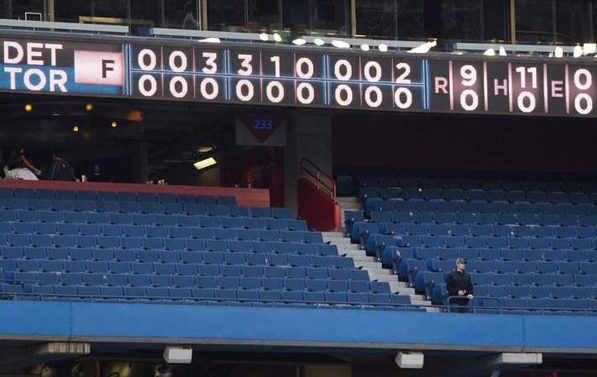
Well, here comes another matchup between the Yankees and the Red Sox – and, while nobody can say for sure who will win any of the games or the series, the one thing we do know for sure is that the games will be long and slow.

These are the two best teams in all of baseball (sorry, Phillies, you might have the best record but you play in a league with Houston, so you’re suspect). These two baseball giants square off this week in what is probably an American League Championship Series preview (sorry, Detroit and Texas, but we do have some lovely parting gifts for you).
Boston and New York have elevated themselves to the top over the last decade by building their teams with almost unlimited funds and an eye toward more accurate player valuations. The Yankees come to Fenway Park with their stars CC Sabathia, Mark Teixeira and Curtis Granderson. The Red Sox are ready with Jacoby Ellsbury, Dustin Pedroia and Adrian Gonzalez. And the lesser names on these two teams would be the top players on almost every other team.
Of course, their acquisitions haven’t always worked out – John Lackey on the Red Sox and A.J. Burnett on the Yankees, along with their excessive contracts would be crippling to most teams. But not for these titans – they have the resources to acquire more talent and move clowns like these two into less-important roles. And they also have the offensive firepower to cover up the awful pitching Lackey and Burnett have been responsible for.
Whenever these two teams go against each other, there’s always a playoff atmosphere – like these games mean something more than the games against other teams. And that’s the nature of a really good rivalry – every player really cares whether they win or not, and it’s not “just another game among 162.” But why, oh why, do their games have to be so long?
It’s simple: some teams have discovered that most of the “usual” statistics that measure player value have been wrong (or at least overvalued), and that other more “nerdy” statistics are actually much more precise. And the statistic that the really smart teams care about is on-base percentage – which just measures the rate at which a batter gets on base.
When I played my first season in little league, I remember the coach going over all the signs that we would be using in the game – when to steal, when to bunt, etc. – and also when to “take” a pitch. And so our first game came along and in my second at bat, the opposing pitcher was wild, so the coach gave me the sign for “take” and when that pitch came in, I swung as hard as I could at a ball that bounced in the dirt. My coach got progressively more confused as he kept signaling for me to “take” and I kept swinging at junky pitches. Well, I later found out that “take” did not mean “take a swing,” – actually it meant the opposite of that. But it never occurred to me that there would ever be a reason to just let the pitcher throw a ball towards home plate without me trying to hit it.
Well, the Yankees and the Red Sox are built around the idea that you need to “take” a bunch of pitches and that a walk is as good as a hit. Getting on base is the important thing. If you get on base, you didn’t make an out. If you don’t make outs, you can keep scoring and scoring and scoring. So, batters now take more pitches because they want to make sure they swing at something worth swinging at and also it increases the chances that they’ll get a walk. This also results in a lot more pitches thrown by the pitchers, wearing them out.
The Red Sox’ Kevin Youkilis is one of the best in the league at this. His nickname is “the Greek god of walks” – so, yeah, he walks a lot. And no matter how bad Derek Jeter’s defense is or how little power he has while batting now, he can still get on base.
If you’re curious which teams have not yet discovered the value of this skill set, just look at the list of top offenses in the league (with the Yankees and Red Sox at the top) and then move your eyeballs down to the bottom of the list. These are the guys who are clinging to old ideas about valuing players by their grittiness, scrappiness, orneriness and clutchy-ness.
And so we constantly have these really long games between the Yankees and Red Sox where each team takes pitch after pitch and guys get on base and pitchers get worn out and relief pitchers come in and they throw pitch after pitch until they get worn out. The games last much longer than the league average – sometimes even lasting longer than four hours.
Well, you’ve probably noticed that I get to write about pretty much whatever I want. And this is a really good example of that. Watch where I take this article right now.
Speaking of things lasting longer than four hours …
We’ve all seen the commercials. You know the ones I’m talking about. They’re for men – older men. They never quite say exactly what they’re for. There’s lots of hints and innuendo and visual metaphors and they talk about “making things happen” when the “moment arrives” with “maximum performance.”
[Editor’s note: Jed, you better be going somewhere with this. Quick.]Most importantly, the ads for these boosters clearly tell us that if your “maximum performance” lasts longer than four hours, you need to contact a physician.

This “four-hour condition” is called priapism – named after the minor fertility god Priapus who was very fertile and also was in a constant state of “maximum performance.” (This is what I use my mental data storage for – there’s no room for my friends’ birthdays or the names of people I meet, but I know about this stuff.)
Anyway, as funny as it sounds, it’s actually a pretty serious condition that needs to be addressed immediately before permanent damage is done. And the cures for priapism range from an ice pack to full-blown surgery. But, as with many questionable decisions made based on or regarding one’s nether-region, many feel that this side-effect is worth the risk.
Okay, so now watch as I bring this right back to baseball.
These four-hour games are not nearly as dangerous, but they are quite excruciating. And, frankly, they’re a little embarrassing. But there’s no way to stop these players from taking pitches – it’s a part of the game now and it’s something that more batters should have been doing a long time ago.
So, we need to find some other way to counteract the side-effects of this new approach by the batters. And there is one easy way to speed things up. Take a look at this next scenario and you’ll see what aspect of the game can be changed with almost no effect on the pitchers, batters or fielders:
The batter steps into the batter’s box. The catcher gives the pitcher a sign for his next pitch. The pitcher throws the ball. The batter takes the pitch. The umpire calls a ball (or strike). The batter steps out of the batter’s box. The batter adjusts his gloves. The batter adjusts his cup. The batter steps back into the batter’s box. The batter signals time out to the umpire. The batter adjusts his helmet. Now the batter is ready.
Pretty obvious, right? Yeah, I know baseball players are superstitious and they think these habits are part of what makes them so good. I’ll clear that up right now: That’s not why. Good. Let’s move forward.
If the batter stays in the batter’s box, then we cut the length of the above scenario in half. And so we could cut the wasted time in half. If we save just five to ten seconds from every pitcher-batter sequence, and there are about 300 of those sequences per game, then we save about 3,000 seconds. That’s like an hour and a half. No, wait. It’s less, like 50 minutes. Whatever. You get the idea.
These Yankees-Red Sox games are the priapism of baseball and we must do something about it. These two teams want their players “making things happen” when the “moment arrives” with “maximum performance.” But let’s speed things up or it’s going to continue be very painful for all of us.






